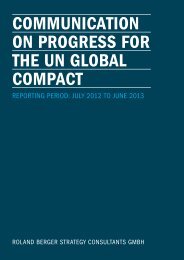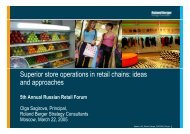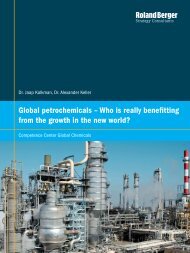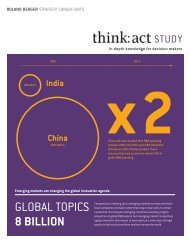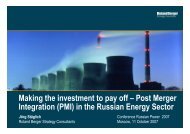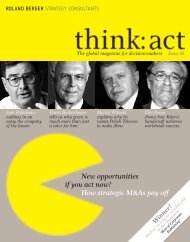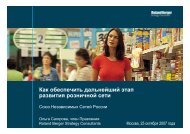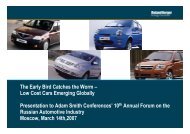PDF, 3464 KB - Roland Berger
PDF, 3464 KB - Roland Berger
PDF, 3464 KB - Roland Berger
You also want an ePaper? Increase the reach of your titles
YUMPU automatically turns print PDFs into web optimized ePapers that Google loves.
DRAFT - 20070204<br />
Opportunities in Russia<br />
- Short overview -<br />
Stuttgart, October 2007<br />
MUC-90007-497-09-03-E.ppt 1
Content<br />
Pages<br />
A. <strong>Roland</strong> <strong>Berger</strong> 3<br />
B. Truck market in Russia is growing by more than 6% 14<br />
C. Important questions to be answered 28<br />
This document was created for the exclusive use of our clients. It is not complete unless supported by the underlying detailed analyses and oral presentation. It must not<br />
be passed on to third parties except with the explicit prior consent of <strong>Roland</strong> <strong>Berger</strong> Strategy Consultants.<br />
MUC-90007-497-09-03-E.ppt 2
A.<br />
<strong>Roland</strong> <strong>Berger</strong><br />
MUC-90007-497-09-03-E.ppt 3
<strong>Roland</strong> <strong>Berger</strong> Strategy Consultants is a global company<br />
NETWORK<br />
75% of all projects with cross-border challenges<br />
1,700 employees<br />
Revenues of EUR 550 m<br />
33 offices in 23 countries<br />
Amsterdam I Barcelona I Beijing I Berlin I Brussels I Bucharest I Budapest I Detroit I Düsseldorf I Frankfurt I<br />
Hamburg I Hong Kong I Kiev I Lisbon I London I Madrid I Manama I Milan I Moscow I Munich I New York I Paris I<br />
Prague I Riga I Rome I São Paulo I Shanghai I Stuttgart I Tokyo I Vienna I Warsaw I Zagreb I Zurich I<br />
MUC-90007-497-09-03-E.ppt 4
We are a top player in the Consulting premier league<br />
EXCELLENCE<br />
Top Management Consulting ranking 2005<br />
Germany<br />
No. 2<br />
Growth regions<br />
China and Russia/CEE<br />
No. 2<br />
Core markets<br />
Western Europe<br />
No. 3<br />
World<br />
No. 5<br />
MUC-90007-497-09-03-E.ppt 5
<strong>Roland</strong> <strong>Berger</strong> has extensive project experience in Russia and Ukraine<br />
Regional presence of <strong>Roland</strong> <strong>Berger</strong> in Russia, Ukraine and the Baltic States<br />
Kiev<br />
Riga<br />
Kharkov<br />
Novgorod<br />
Obninsk<br />
Orsk<br />
Lipetsk<br />
St.Petersburg<br />
Moscow<br />
Vladimir<br />
Novotroitsk<br />
Cherepovets<br />
Novokuznetsk<br />
N.Novgorod<br />
Kazan<br />
Togliatti Nab. Serow<br />
Tshelny<br />
Volzhsky<br />
Ekaterinburg<br />
Kamensk-<br />
Uralsky<br />
Kurgan<br />
Stepnoye Ozero<br />
Surgut<br />
Novosibirsk<br />
Krasnoyarsk<br />
70 consultants with project work experience<br />
in the following fields:<br />
– Marketing/Sales<br />
– Operations Strategy<br />
– PMI, Organization and HR<br />
– Production/Technology<br />
– Procurement<br />
– Restructuring<br />
– Strategy development<br />
3 major client groups:<br />
– Major local companies<br />
– Global companies<br />
– International financial institutions and<br />
state organizations<br />
Dedicated automotive team for Russia and<br />
Ukraine, integrated into Global <strong>Roland</strong> <strong>Berger</strong><br />
Automotive Competence Center<br />
<strong>Roland</strong> <strong>Berger</strong> Offices<br />
Project locations<br />
Source: <strong>Roland</strong> <strong>Berger</strong><br />
Vladivostok<br />
MUC-90007-497-09-03-E.ppt 6
For more than 10 years we have served our clients to overcome all<br />
crises and to expand successfully in Central and Eastern Europe<br />
<strong>Roland</strong> <strong>Berger</strong> Strategy Consultants in Central and Eastern Europe<br />
Poland<br />
Established 1999 No. of employees: 38<br />
Russia, Ukraine, Baltic states<br />
Established 1994 No. of employees: 73<br />
Czech Republic<br />
Established 1993 No. of employees: 29<br />
Vienna<br />
Zagreb<br />
Riga<br />
Moscow<br />
Warsaw<br />
Prague<br />
Kiev<br />
Budapest<br />
Bucharest<br />
HYPERCENTER<br />
Romania<br />
Established 1992 No. of employees: 26<br />
Croatia<br />
Established 2003 No. of employees: 10<br />
Hungary<br />
Established 1996 No. of employees: 8<br />
MUC-90007-497-09-03-E.ppt 7
We have gained wide-ranging experience in Russia through large<br />
projects with automotive clients<br />
Selected clients and projects in Russia, Ukraine and the Baltic States<br />
SELECTED PROJECT CONTENTS<br />
SELECTED CLIENTS<br />
• Market analysis<br />
– macroeconomics<br />
– market and competition<br />
– sales structure and pricing<br />
– target groups<br />
• Strategic reorientation<br />
– vertical integration<br />
– regional expansion<br />
– supply chain management (upstream<br />
& downstream)<br />
– partner search<br />
• Change management<br />
– innovation management<br />
– brand management<br />
MUC-90007-497-09-03-E.ppt 8
<strong>Roland</strong> <strong>Berger</strong> Strategy Consultants – Contacts in Berlin, the CIS<br />
and the Baltic states<br />
Berlin<br />
Alt Moabit 101b D-10559 Berlin<br />
Tel.: +49-30-3 99 27 50<br />
Fax: +49-30-3 99 27 30 3<br />
e-mail: uwe_kumm@de.rolandberger.com<br />
Moscow<br />
125047, Moscow, 1st Tverskaya-Yamskaya 23<br />
Тel.: +7-495-721-19-51<br />
Fax +7-495-721-19-54<br />
e-mail: office_moscow@ru.rolandberger.com<br />
Dr. Uwe Kumm<br />
Managing partner<br />
Member of the Management Committee Central and<br />
Eastern Europe (CEE)<br />
Dr. Uwe Kumm<br />
Managing Partner<br />
Dr. Sergei Shibaev<br />
Partner<br />
Vladimir Boroutski<br />
Principal<br />
Alexander Nefjodov<br />
Principal<br />
Dr. Olga Sagirova<br />
Principal<br />
Boris Firsov<br />
Principal<br />
Kiev<br />
ul. Schelkovichnaya 42/44<br />
01004 Kyiv, Ukraine<br />
Tel.: +380 44 49408-65<br />
Fax: +380 44 49408-64<br />
e-mail: thomas_winkelmann@ua.rolandberger.com<br />
konstantin_mezentsev@ru.rolandberger.com<br />
Dr. Uwe Kumm<br />
Managing partner<br />
Konstantin Mezentsev<br />
Principal<br />
Dr. Thomas Winkelmann<br />
Senior Advisor<br />
Riga<br />
Brivibas 99-5, LV-1001 Riga, Latvia<br />
Tel.: +371-7360169<br />
Fax: +371-7370590<br />
e-mail: Office_Riga@rolandberger.com.lv<br />
Arnis_Blukis@lv.rolandberger.com<br />
Dr. Uwe Kumm<br />
Managing partner<br />
Arnis Blukis<br />
Consultant<br />
MUC-90007-497-09-03-E.ppt 9
The automotive and supplier industry should quickly seize the<br />
opportunities offered in Russia<br />
Study on developing a competitive Russian automotive supplier industry<br />
CLIENT<br />
• Committee on Eastern European<br />
Economic Relations and several large<br />
German and European car producers<br />
and suppliers<br />
OBJECTIVE<br />
• Developing a competitive Russian<br />
automotive supplier industry<br />
• Create transparency about current<br />
situation in the Russian automotive<br />
industry<br />
Overview participants<br />
INITIATOR:<br />
Committee on Eastern European Economic Relations<br />
Structure of interviews in Europe [%] Structure of interviews in Russia [%]<br />
12 4 53<br />
Total: 25<br />
Total: 30<br />
OEMs<br />
OEMs<br />
Others 1)<br />
Developing a<br />
10<br />
competitive<br />
Russian<br />
Suppliers<br />
84<br />
industry Others 1)<br />
automotive<br />
37<br />
Suppliers<br />
SPONSORS<br />
METHODOLOGY<br />
• Conducting interviews with all major<br />
Russian and European car<br />
manufacturers and automotive<br />
suppliers<br />
• Developing scenarios for the further<br />
development of the Russian<br />
automotive industry<br />
Source: <strong>Roland</strong> <strong>Berger</strong><br />
Russian new car market<br />
2004-2014e [m cars] 1)<br />
SALES VOLUME<br />
Imported cars<br />
Local production<br />
international OEMs<br />
Russian OEMs<br />
1.3<br />
0.3<br />
0.1<br />
+7% p.a.<br />
2.0<br />
0.6<br />
+6% p.a.<br />
2.3<br />
0.7<br />
2)<br />
0.6 0.8<br />
0.9 0.8 0.8<br />
2004 2010e 2014е<br />
COMMENTS<br />
• Increase in sales of the foreign OEMs<br />
caused by increasing income and<br />
increasing customer demand for<br />
comfort/security<br />
• Future local assembly of international<br />
OEMs<br />
• Russian OEMs are able to keep their<br />
position only in case of modernization<br />
MUC-90007-497-09-03-E.ppt 10
Boosting sales in Russia – Individually tailored project for a medium-sized<br />
European car manufacturer<br />
Market entry strategy development<br />
CLIENT<br />
• Medium-sized European car<br />
manufacturer<br />
Market survey<br />
Sales up program<br />
Setup of general<br />
importer<br />
Local assembly<br />
OBJECTIVE<br />
• Establish a clear picture of the local<br />
situation<br />
• Define sales-boosting program for<br />
price, product, dealer network and<br />
marketing<br />
• Evaluate option for local production in<br />
Russia, Kazakhstan, Ukraine or<br />
Belarus<br />
DELIVERABLES<br />
2,800<br />
Neuwagenverkauf [Tsd.]<br />
2,600<br />
2,400<br />
2,200<br />
2,000<br />
1,800<br />
1,600<br />
1,400<br />
1,200<br />
1,000<br />
800<br />
Optimistisches Szenario<br />
Realistisches Szenario<br />
2.639<br />
2.014<br />
1.200<br />
Pessimistisches Szenario<br />
2002 2003 2004 2005 2006 2007 2008 2009 2010<br />
Zeitverlauf<br />
• Survey of car<br />
drivers<br />
• Market research<br />
• Detailed<br />
knowledge of the<br />
market (Factbook)<br />
UP<br />
SALES<br />
• Recommendations<br />
regarding price<br />
positioning,<br />
specifications,<br />
dealership,<br />
advertising and<br />
promotion<br />
• Ad-hoc take-over<br />
of existing import<br />
structures<br />
• Medium-term<br />
development of<br />
local resources<br />
• Medium-term<br />
setup of local<br />
assembly in order<br />
to minimize import<br />
tariffs (RUS, KZ,<br />
UA)<br />
• Detailed market analysis incl. a<br />
survey among more than 500 end<br />
customers in different regions and<br />
more than 40 interviews with top<br />
executives<br />
• Development of detailed "factbook"<br />
on the Russian automotive market<br />
• Definition of measures to boost sales<br />
• Suggestions for the<br />
neutralization of<br />
deficiencies in<br />
product and price<br />
positioning, setup of<br />
the dealer network<br />
and communication<br />
Source: <strong>Roland</strong> <strong>Berger</strong><br />
MUC-90007-497-09-03-E.ppt 11
Overwhelming response rate of potential Russian partners interested in<br />
setting up license production of automotive parts<br />
Partner search to set up license production for a large European supplier<br />
CLIENT<br />
• Major European automotive supplier<br />
for nearly all large European car<br />
producers<br />
The Russian industry is highly interested in forging international<br />
partnerships<br />
OBJECTIVE<br />
• Find a partner to localize license<br />
production in Russia<br />
DELIVERABLES<br />
• Market screening for potential<br />
partners<br />
• Compiling long list and short list of<br />
potential partners<br />
• Organizing a Roadshow at potential<br />
partners<br />
Results of our survey<br />
100% 65% 52%<br />
23<br />
Companies<br />
contacted<br />
8<br />
Not interested or not<br />
enough resources<br />
15<br />
Companies visited<br />
by <strong>Roland</strong> <strong>Berger</strong><br />
3<br />
12<br />
Companies<br />
appropriate as a<br />
potential licensing<br />
partner<br />
Comments<br />
• The project aim was to<br />
identify a licensing partner<br />
for a German automotive<br />
supplier<br />
• Russian suppliers (57%) and<br />
companies that announced<br />
plans to expand into the<br />
automotive supply sector<br />
(43%) were contacted<br />
• Almost all companies were<br />
in possession of appropriate<br />
material resources<br />
Source: <strong>Roland</strong> <strong>Berger</strong><br />
MUC-90007-497-09-03-E.ppt 12
Determining market potential and developing a market entry strategy with<br />
potential local partners<br />
Study on market potential and partner search for Austrian automotive supplier<br />
CLIENT<br />
• Leading Austrian automotive supplier with<br />
worldwide activities<br />
• Global niche manufacturer<br />
• So far only very limited activities in the<br />
CIS countries<br />
OBJECTIVE<br />
• Exploiting the growth opportunities in the<br />
dynamic CIS markets<br />
– Estimating the market potential<br />
– Developing the market entry strategy<br />
based on the general business plan<br />
METHODOLOGY<br />
• Assessing market volume, competition,<br />
value added, etc. in the target countries<br />
(RU, UA, BY, KZ)<br />
• Evaluating the potential partnership with<br />
the identified partner<br />
• Conducting strategy workshops with the<br />
client<br />
The project approach consisted of four key modules which were<br />
designed to deliver the optimal market entry strategy<br />
Project<br />
approach<br />
Austria<br />
Analyze the<br />
market potential<br />
2010<br />
2004<br />
Automotive<br />
market<br />
Relevant<br />
supplier market<br />
RU UA BY KZ<br />
Belarus<br />
Ukraine<br />
Russia<br />
Develop the<br />
general business<br />
plan<br />
• Sales concept<br />
• Cost plan<br />
• Investment plan<br />
• Financing model<br />
Kazakhstan<br />
Develop the<br />
market entry<br />
strategy<br />
Options:<br />
• No activities<br />
• Export<br />
• JVproduction<br />
Greenfield<br />
Filter<br />
Decision<br />
Define<br />
next steps<br />
• First evaluation of<br />
potential partners<br />
• Agree onthe<br />
further decisions<br />
to be taken and<br />
define next steps<br />
Source: <strong>Roland</strong> <strong>Berger</strong><br />
MUC-90007-497-09-03-E.ppt 13
B.<br />
Truck market in Russia is growing by more than 6%<br />
MUC-90007-497-09-03-E.ppt 14
Overview<br />
• Traditional markets are determined by high market cycle; market growth of the last<br />
years are caused by new emission and safety requirements<br />
• Main growth potential is in the emerging markets: China, India, Brazil, Russia and<br />
Central and Eastern European Countries (CEE); Strong GDP growth leads to an<br />
increased demand for transportation and increased truck due sales<br />
• In the next years (2005-2013) truck sales in the Russia is growing very fast<br />
– Russia: 6-8% p.a.<br />
– CEE: 4% p.a.<br />
• Especially the emerging markets looking for low cost trucks. Two options are<br />
available: downgrading of existing trucks or development of new low cost trucks<br />
• To answer on the local markets three enablers are important<br />
– Low cost brand (entirely defined product portfolio, etc.)<br />
– Low cost product (platform, component sharing, technology level, etc.)<br />
– Low cost operations (sourcing, production, etc.)<br />
MUC-90007-497-09-03-E.ppt 15
Strongest relative growth expected in CEE – Asia is the largest<br />
market with strongest absolute sales<br />
Market shares and growth 2005-2013 LCV and MDT/HDT [%]<br />
North America<br />
37%<br />
28%<br />
Asia 2)<br />
+8.1% +6.0%<br />
South America 1)<br />
-0.2% +1.2%<br />
17% 17%<br />
35%<br />
+1.4% +2.1%<br />
3%<br />
5%<br />
Europe<br />
Central/Eastern Europe 3)<br />
4%<br />
5%<br />
43%<br />
+7% +3.5%<br />
+2.9% +3.3%<br />
x% Share of annual global sales LCV 2005<br />
x% Share of annual global sales MDT/HDT2005<br />
LCV: CAGR 2005-2013 HDT/MDT: CAGR 2005-2013<br />
X.X % X.X %<br />
Source: J.D. Power; <strong>Roland</strong> <strong>Berger</strong><br />
1) Incl. Brazil 2) Incl. China and India 3) Incl. Russia, Turkey and Ukraine<br />
MUC-90007-497-09-03-E.ppt 16
RUSSIA<br />
Truck in Russia market will grow by 6-8%<br />
Economic key data 2006/Condiition<br />
• Population [m] 142.3<br />
• Real GDP growth p.a. [06-10] 5.1%<br />
• Inflation [%] 9.7<br />
• Varying climate conditions:<br />
– Humid continental (European part)<br />
– Sub arctic in Siberia<br />
– Tundra climate in the polar North<br />
• Length of road network 1) 537,000 km<br />
– 67% paved<br />
– Ratio (length/area) 0.031<br />
• Type of traffic system LHD vehicles<br />
Competitors LCV – Market share [%]<br />
Citroen<br />
7<br />
Mitsubishi 7<br />
Zhongxing 7<br />
Other<br />
11<br />
8<br />
VW<br />
13<br />
Great Wall Motors<br />
20<br />
Izh<br />
15 Ford<br />
14<br />
Renault<br />
CV sales by segment 2005 vs. 2013<br />
Sales [’000]<br />
LCV<br />
MDT/<br />
HDT<br />
Other<br />
94<br />
2006 2012<br />
37<br />
3<br />
ZIL 7<br />
UAZ<br />
10<br />
140<br />
131<br />
KAMAZ<br />
180<br />
43 GAZ<br />
CAGR<br />
2006-2012<br />
8%<br />
6%<br />
Competitors MDT/HDT – Market share [%]<br />
Further comments<br />
• After reforms, emerged private<br />
business created huge<br />
demand for LCVs<br />
• Local players dominate<br />
MDT/HDT market; local trucks<br />
are based on old concepts<br />
• In Soviet times, MDT were<br />
used for most kinds of<br />
transportation<br />
• Growth of road freight resulted<br />
in increasing demand for truck<br />
tractors in HD segment<br />
• Foreign OEMs have little<br />
interest in LCV and MD<br />
segments – hard to compete<br />
on price with GAZ<br />
• High imports of HD trucks<br />
(truck tractors, esp. used<br />
imports due to better pricequality<br />
ratio compared to<br />
KAMAZ, MAZ)<br />
Source: J.D. Power; CSM; Economist Intelligence Unit (EIU); BFAI; <strong>Roland</strong> <strong>Berger</strong><br />
MUC-90007-497-09-03-E.ppt 17
Four main drivers explain demand for new commercial vehicles<br />
Growth drivers of commercial vehicle market<br />
ECONOMICAL<br />
DEVELOPMENT<br />
FREIGHT<br />
TONNAGE<br />
EMISSION<br />
REGULATION<br />
ROAD<br />
INFRASTRUCTURE<br />
Impact on<br />
EMERGING<br />
markets<br />
• Long term strong and<br />
stable growth of CV<br />
sales<br />
• GDP is still driven by<br />
growing industrial<br />
production<br />
• Growth in industrial<br />
production will drive<br />
tonnage<br />
• Emission regulation less<br />
than in Triade markets<br />
• Stricter standards in<br />
China and India from<br />
2010 onwards<br />
• Besides different climatic<br />
condition<br />
• Infrastructure is growing<br />
but needs time<br />
Impact on<br />
TRIADE<br />
Markets<br />
• Direct correlation<br />
limited<br />
• GDP growth indicates<br />
only long term trend of<br />
market but not the<br />
fluctuation in the market<br />
• Closely related to<br />
industrial production<br />
• Most relevant driver for<br />
the truck sales<br />
• Truck market growth<br />
limited after introduction<br />
of new emission<br />
regulations<br />
• Most technological<br />
adaptations already<br />
introduced<br />
• Toll Collect systems<br />
have limited impact on<br />
the road usage<br />
Source: Economist Intelligence Unit (EIU); ATA; Global Insight; J.D. Power; <strong>Roland</strong> <strong>Berger</strong><br />
MUC-90007-497-09-03-E.ppt 18
Especially in the MDT and HDT market, players from emerging<br />
markets have an important role<br />
Global commercial vehicle sales by OEM 2005 [‘000 units]<br />
1<br />
Top-15 OEMs LCV<br />
Market share LCC OEMs<br />
2<br />
Top-15 OEMs MDT / HDT<br />
1,898<br />
408<br />
1,832<br />
187<br />
1,183<br />
150<br />
954<br />
143<br />
PSA<br />
792<br />
564<br />
419<br />
80%<br />
69%<br />
133<br />
129<br />
118<br />
310<br />
99<br />
304<br />
87<br />
293<br />
85<br />
288<br />
74<br />
239<br />
217<br />
20%<br />
31%<br />
74<br />
69<br />
180<br />
50<br />
172<br />
LCV<br />
MDT/HDT<br />
47<br />
Triade OEMs<br />
Source: J.D. Power; Global Insight; <strong>Roland</strong> <strong>Berger</strong><br />
Emerging market OEMs<br />
MUC-90007-497-09-03-E.ppt 19
Today the biggest truck production plants in CEE are located in<br />
Russia<br />
Production is planned<br />
Source: ASM-Holding, <strong>Roland</strong> <strong>Berger</strong> analysis<br />
MUC-90007-497-09-03-E.ppt 20
Some OEMs are already active in the emerging markets – Usually<br />
JVs or strategic partnerships<br />
OEM in emerging markets by vehicle segment<br />
LCV<br />
MDT/HDT<br />
– –<br />
– JV<br />
–1 )<br />
–<br />
–<br />
–<br />
1) JV with UralAZ<br />
Source: Marklines; <strong>Roland</strong> <strong>Berger</strong><br />
MUC-90007-497-09-03-E.ppt 21
Cost savings resulting from local production can become a significant<br />
competitive advantage in the long term for the foreign companies<br />
Activities of foreign commercial vehicle producers in Russia and Belarus<br />
Company<br />
Overview activities<br />
• CKD-assembly of FM-, FH-Ranges in Zelenograd near Moscow since<br />
03/2003 – No localization, assembly kits imported<br />
• JV 66% Volvo, 34% AFK Sistema<br />
• Approx. 30 employees<br />
• Production of 220 units in 2004 and approximately 400 units in 2005<br />
• Assembly of MAZ-MAN tractors for semi-trailers in Minsk/Belarus –<br />
Trade-free zone with Russia, Production of 272 units in 2004<br />
• JV, 51% MAN, 39% MAZ, 10% Lada OMS-Holding<br />
• Small volumes – MAN TGA assembly since December 2005<br />
• Production of Hyundai Porter (max. load 1t) by TAGAZ, SOP in 2005<br />
• Foundation of assembly facility for heavy duty trucks and buses in<br />
Rostov by the assembly partner TAGAZ announced<br />
• License agreement for the production of dCi engines with 11l<br />
displacement signed with GAZ/Ruspromavto<br />
• Further cooperation in the area of LCV possible<br />
Source: Autoreview, ASM-Holding, <strong>Roland</strong> <strong>Berger</strong><br />
MUC-90007-497-09-03-E.ppt 22
The low cost trucks in emerging markets differentiate primarily by<br />
performance, comfort, fuel consumption and emission<br />
Comparison heavy duty truck [>15 to GVW]<br />
STANDARD TRUCKS<br />
LOW COST TRUCK<br />
Performance • In average approximately 450 HP, maximum 600 HP • In average approximately 300 HP, maximum 360<br />
HP<br />
Comfort<br />
Safety<br />
Chassis /<br />
frame<br />
• High comfort cabin with air condition as common<br />
standard<br />
• Automatic gearshift partly standard<br />
• Optional safety features (e.g. lane departure<br />
warning and adaptive cruise control)<br />
• Air suspension common option<br />
• Only high end trucks with comfort cabin and air<br />
condition<br />
• Manual gearshift<br />
• No electronic safety features available<br />
• Comparable frame design as in Europe<br />
• Steal spring suspension as standard<br />
Fuel consumption<br />
• About 35 liters per 100 km for 40 t GVW • 35-50 liters per 100 km for 40 t GVW 1)<br />
Emission<br />
• In North America (EPA 2004) and Western Europe<br />
(EURO IV)<br />
• EGR, SCR, and DPF 2) as standard<br />
• 5 years gap in emission regulations (e.g. EURO IV<br />
in China in 2010), limited applications of exhaust<br />
gas technology<br />
Price •Avg.USD 100,000 • USD 30,000-40,000 in China; USD 60,000 in<br />
Russia<br />
1) Gross vehicle weight 2) EGR = Exhaust gas regulation; DPF = Diesel particle filter; SCR = Selective Catalytic Reduction 3) 1USD = 0,77 EUR<br />
Source: Company information; <strong>Roland</strong> <strong>Berger</strong><br />
MUC-90007-497-09-03-E.ppt 23
COMMERCIAL VEHICLES<br />
Leading truck manufacturers offer low cost versions prepared<br />
specially for the local market<br />
Specific models for the Russian market<br />
Scania<br />
Source: www.autoreview.ru, <strong>Roland</strong> <strong>Berger</strong>-analysis<br />
Volvo<br />
Model • P114GA Griffin • FM12 "Region"<br />
Powertrain • 340 hp, Euro-3, 4x2 • 340 hp, Euro-3, 4x2<br />
Country of origin • Brazil • Russia<br />
Price incl. VAT • EUR 68,500 • EUR 74,000<br />
Leasing offer • 42 m leasing period • 42 m leasing period<br />
• Downpayment EUR 10,275• Downpayment EUR 14,800<br />
• Monthly rate EUR 1,774<br />
• Interest 8% p.a.<br />
• Monthly rate EUR 2,000<br />
• Interest n.a.<br />
Insurance and 1<br />
year of service<br />
Total costs over<br />
3.5 years<br />
Number of<br />
service stations<br />
in Russia<br />
• Plus 2,965 EUR<br />
• Included<br />
• EUR 87,748 • EUR 98,800<br />
Payload • 18,000 Kg • 18,000 Kg<br />
• 23 • 25<br />
• Simplified versions<br />
(1 bed in cabin,<br />
minimum additional<br />
equipment)<br />
• Minimal engine power<br />
• Serial assembly, no<br />
choice of versions is<br />
possible<br />
• Final assembly in the<br />
low cost countries<br />
• Combination with the<br />
own financing offer<br />
MUC-90007-497-09-03-E.ppt 24
Russia is the largest market for trucks in CIS and will keep this<br />
position until 2012<br />
Dynamics of the truck market by country in 2002-2012 ['000 units] 1)<br />
Kazakhstan<br />
Ukraine<br />
Russia<br />
194<br />
13%<br />
83%<br />
4%<br />
225<br />
4%<br />
16%<br />
80%<br />
12% p.a.<br />
235<br />
5%<br />
17%<br />
78%<br />
245<br />
7%<br />
17%<br />
76%<br />
303<br />
7%<br />
16%<br />
77%<br />
411<br />
8%<br />
16%<br />
76%<br />
CAGR<br />
2006-12<br />
9%<br />
5%<br />
5%<br />
Comments<br />
• In 2012 trucks in Russia<br />
will outsell by three<br />
times both Ukraine and<br />
Kazakhstan combined<br />
• Kazakhstan market has<br />
the greatest potential<br />
for growth; by 2012 it<br />
will be a half of<br />
Ukrainian one with<br />
higher share of heavy<br />
trucks<br />
2002 2003 2004 2005 2006 2012<br />
1) Russia does not include used trucks data, Ukraine and Kazakhstan include used trucks data<br />
Source: <strong>Roland</strong> <strong>Berger</strong> analysis<br />
MUC-90007-497-09-03-E.ppt 25
RUSSIA<br />
2002-2006 CAGR has been at 8%; Sales of foreign trucks showed the<br />
highest growth rate<br />
Truck market volume in Russia by origin in 2002-2006 ['000 units]<br />
8.1% p.a.<br />
CAGR<br />
Comments<br />
Used trucks<br />
import<br />
New trucks<br />
import<br />
Assembled<br />
in Russia<br />
Russian brands<br />
218<br />
26%<br />
7%<br />
67%<br />
0%<br />
264<br />
27%<br />
7%<br />
8%<br />
65%<br />
243<br />
25%<br />
8%<br />
67%<br />
0%<br />
243<br />
23%<br />
10%<br />
66%<br />
1%<br />
298<br />
21%<br />
12%<br />
3%<br />
64%<br />
3%<br />
24%<br />
232%<br />
7%<br />
• Market share of local<br />
(Russian) producers<br />
decreased from 67% in<br />
2002 to 64% in 2006<br />
• Highest growth rates<br />
shown by assembly of<br />
foreign trucks in<br />
Russian can be<br />
explained by the fact<br />
that assembling of<br />
foreign trucks was<br />
almost equal to zero in<br />
2002<br />
2002 2003 2004 2005 2006<br />
• Importofnewtrucks<br />
grew at 24% p.a. meanwhile<br />
import of used<br />
trucks – at 3% p.a.<br />
Source: ASM Holding, Goskomstat, JD Power, RAS, press, <strong>Roland</strong> <strong>Berger</strong> analysis<br />
MUC-90007-497-09-03-E.ppt 26
RUSSIA<br />
For the last 5 years shares of market segments have changed<br />
slightly; light trucks still comprise 60% of sales<br />
Truck market 1) dynamics in Russia by segment in 2002-2006 ['000 units]<br />
9.9% p.a.<br />
CAGR<br />
Comments<br />
3<br />
2<br />
HDT<br />
MDT<br />
161<br />
20%<br />
16%<br />
177<br />
20%<br />
16%<br />
183<br />
22%<br />
18%<br />
187<br />
23%<br />
17%<br />
234<br />
24%<br />
16%<br />
15%<br />
10%<br />
• Demand for heavy trucks<br />
has been growing at 15%<br />
CAGR basically due to<br />
construction boom<br />
• Middle trucks gradually<br />
reenter the segment<br />
where they have been<br />
replaced with light trucks<br />
1<br />
LCV 64% 63% 60% 60%<br />
60%<br />
8%<br />
• Light trucks show the least<br />
growth, but still have the<br />
highest market share<br />
2002<br />
2003<br />
1) Does not include used trucks in import<br />
2004<br />
2005<br />
2006<br />
Source: ASM Holding, Goskomstat, JD Power, RAS, press, <strong>Roland</strong> <strong>Berger</strong> analysis<br />
MUC-90007-497-09-03-E.ppt 27
C.<br />
Important questions to be answered<br />
MUC-90007-497-09-03-E.ppt 28
Entering the market with a strong partner is important for the<br />
success in Russia<br />
Success factors and respective comments<br />
Key success factors in Russia<br />
a<br />
e<br />
b<br />
Diversity product<br />
portfolio<br />
c<br />
d<br />
Long-term<br />
commitment<br />
Local network/<br />
partnering<br />
Usage of cost<br />
advantages<br />
Local networking<br />
• Product production in Russia should not solely depend on customers<br />
requirements in Russia; different approaches should be considered<br />
also LowCost truck (new brand) for Western Europe, CIS, etc.<br />
• Adaptation of product concept<br />
• Long-term commitment necessary to be able to respond to the future<br />
needs of the clients and to create positive perception by authorities<br />
• Products and know-how of Russian suppliers are not state-of-the-art<br />
– modernization of the industry is necessary<br />
• Very careful partner selection is necessary to ensure project‘s longterm<br />
success and enable fast entry (e.g. supplier, service and<br />
aftersales network)<br />
• Low production costs<br />
• Numerous federal and local incentives will increase profitability and<br />
will decrease pay-back period (e.g. tax incentives, special economic<br />
zones)<br />
• Close network to federal authorities (Political/regulatory risk)<br />
• Sponsoring of locals increase acceptance<br />
Source: <strong>Roland</strong> <strong>Berger</strong><br />
MUC-90007-497-09-03-E.ppt 29
a<br />
Different behavior of customers in emerging markets vs. Triade<br />
markets<br />
Purchasing behavior<br />
TRIADE MARKETS<br />
EMERGING MARKETS<br />
Tax<br />
Tires<br />
Capital Costs<br />
4%<br />
4%<br />
Insurance<br />
1%<br />
7%<br />
Maintenance<br />
9%<br />
38%<br />
Labor<br />
• Strong cash flow orientation of<br />
owners of emerging markets<br />
• Start-up investment are crucial for<br />
truck purchasing<br />
Depreciation<br />
12%<br />
27%<br />
Fuel Costs<br />
Focus on total cost of ownership Focus on investment<br />
Source: Company information; <strong>Roland</strong> <strong>Berger</strong><br />
MUC-90007-497-09-03-E.ppt 30
c<br />
In the mid term, local suppliers will only be able to reach a<br />
international level through cooperation with their foreign pees<br />
Production of parts reaching international standards in Russia<br />
Opportunity for Russian suppliers to set up<br />
a production of components according to<br />
international standards [%]<br />
Comments<br />
With<br />
JV partner<br />
Alone<br />
~25%<br />
~72%<br />
• Supplier industry transformation largely only<br />
possible with international support<br />
• Russian suppliers benefit from joint ventures<br />
with international suppliers in the following<br />
areas:<br />
– Technology<br />
– Production process<br />
– Quality management<br />
No<br />
opportunity<br />
~3%<br />
• In turn, the Russian partners can make the<br />
following contributions:<br />
– Access to customers<br />
– Local access to authorities, etc.<br />
– Existing structures<br />
Source: <strong>Roland</strong> <strong>Berger</strong> survey<br />
MUC-90007-497-09-03-E.ppt 31
c<br />
Supplier market for local production grows at 20% p.a. – increasing<br />
localization and outsourcing share as major growth drivers<br />
Development of the car supplier market 2005-2014<br />
Supplier market for local<br />
production [EUR bn]<br />
Growth forces [%]<br />
Comments<br />
0.9<br />
0.1<br />
0.8<br />
+ 20% p.a.<br />
2.7<br />
1.6<br />
2005 2010<br />
4.8<br />
3.6<br />
1.1 1.2<br />
For<br />
foreign<br />
OEMs<br />
For<br />
Russian<br />
OEMs<br />
26<br />
43<br />
2014 Russ.<br />
OEMs<br />
OUTSOURCING<br />
66 70 91<br />
Int.<br />
OEMs<br />
LOCAL CONTENT<br />
80<br />
Russ.<br />
OEMs<br />
12<br />
36<br />
Int.<br />
OEMs<br />
• Supplier market for local<br />
production grows at 20%<br />
p.a. on average<br />
• Supplier industry will<br />
take over a greater<br />
share of value creation<br />
from OEMs in the future<br />
• Triple growth of local<br />
procurement volumes of<br />
foreign OEMs<br />
• International suppliers<br />
have better chances to<br />
benefit from this growth<br />
– if they localize<br />
2005 2010<br />
Source: ASM Holding, Goskomstat, <strong>Roland</strong> <strong>Berger</strong><br />
MUC-90007-497-09-03-E.ppt 32
c<br />
Products and know-how of Russian suppliers are not state-of-theart<br />
– modernization of the industry is necessary<br />
Supplier industry situation and problems in Russia<br />
Situation on the local supplier industry<br />
Problems of the supplier industry<br />
• Russian OEMs have quite high vertical<br />
integration – for this reason there is no<br />
developed supplier industry yet<br />
• Products for Russian OEMs don’t correspond<br />
to western standards<br />
• Actual environmental guidelines (EURO-3 etc.)<br />
are partially not yet implemented<br />
• Western OEMs determine the growth of the car<br />
market, however their production volume is<br />
still too low<br />
• Import duties for component (5-20% without any<br />
special conditions) are already quite low<br />
• Traditional close ties with one OEM<br />
• Uncompetitive products<br />
• Modernization is necessary to reach western<br />
production standards<br />
• Insufficient know-how for the production of modern<br />
and complex components<br />
• Investments into modern production capacities<br />
and products for western OEMs are still very often<br />
unprofitable because of low volumes<br />
• Import of western components for local assembly is<br />
still a reasonable alternative<br />
Source: <strong>Roland</strong> <strong>Berger</strong><br />
MUC-90007-497-09-03-E.ppt 33
d<br />
Labor cost in Russia are among the lowest in the World, but the<br />
level of the wages depends on the Region<br />
Labor cost comparison 2004<br />
Average hourly cost of labor 1)<br />
[EUR]<br />
Average monthly nominal wages in selected<br />
Russian Regions 2) [EUR]<br />
Germany<br />
France<br />
15.7<br />
25.3<br />
250<br />
Moscow<br />
Czech Rep.<br />
Hungary<br />
4.2<br />
5.0<br />
200<br />
St.<br />
Petersburg<br />
Poland<br />
Slovakia<br />
Turkey<br />
Romania<br />
1.8<br />
1.8<br />
2.9<br />
4.1<br />
150<br />
100<br />
Samara<br />
N. Novgorod<br />
Russia 3)<br />
Ukraine<br />
1.7<br />
0.8<br />
50<br />
2000 2001 2002 2003<br />
1) Average hourly compensation of production workers including benefits (data for 2004)<br />
2) Excluding social cost; average wages in industrial sector actually a little higher, but no specific data available<br />
3) Regional costs can vary - Example AvtoVAZ assembly line: labor costs are 2.8 EUR per hour<br />
Source: EIU, CE-Research LLP, Russian Federal Statistics Office, <strong>Roland</strong> <strong>Berger</strong> analysis<br />
MUC-90007-497-09-03-E.ppt 34
d<br />
The Leningrad Region offers the most attractive investment<br />
incentives – subsidies granted even after the payback period<br />
Reduction in profit taxes during the payback<br />
period or maximum 5 years<br />
Reduction in profit taxes after the payback<br />
period<br />
4%<br />
0%-4%<br />
0%-4%<br />
1.2%-4%<br />
0%<br />
0%<br />
0%<br />
0%<br />
Leningrad N. Novgorod Samara Moscow<br />
Leningrad<br />
region 1) region2)<br />
region region<br />
region 3)<br />
N. Novgorod<br />
region<br />
Samara<br />
region<br />
Moscow<br />
region<br />
Reduction in property taxes during the payback<br />
period or maximum 5 years<br />
Reduction in property taxes after the payback<br />
period<br />
2.2%<br />
0%-2.2%<br />
0%-2.2%<br />
0.7%-2.2%<br />
0%<br />
0%<br />
0%<br />
0%<br />
Leningrad N. Novgorod Samara Moscow<br />
Leningrad<br />
region 1) region region region<br />
region 3)<br />
N. Novgorod<br />
region<br />
Samara<br />
region<br />
Moscow<br />
region<br />
1) For the entire payback period 2) For larger Greenfield projects 4% 3) For two years, maximum reduction applies for investments > USD 50 m<br />
Source: Interviews, Regional investment laws<br />
MUC-90007-497-09-03-E.ppt 35
e<br />
Decree 166 allows to avoid import duties on components in echange<br />
for the gradual localization of the products<br />
Duration of validity • Greenfield – 8 years<br />
• Brownfield–7years<br />
Tariff duties for the<br />
import of components<br />
Decret 166 – "Industrial assembly" (April 2005)<br />
• From Ø 14.5% to Ø2%(weighted average 2) )<br />
Required investment • No minimum investment<br />
Requirements on the<br />
production volume<br />
Requirements on<br />
manufacturing content<br />
Local content<br />
requirements 1)<br />
• Minimum production capacity 25,000 units/a (2 shifts) – no regulation<br />
on actual production output<br />
• Welding/Painting/Assembly<br />
– Greenfield 30 months after SOP 3)<br />
– Brownfield 18 months after SOP 3)<br />
Local integration targets as reduction in value of the standard component<br />
list (can be achieved through paying regular duties on the components)<br />
• 10% – 24 months after SOP 3)<br />
• 20% – 42 months after SOP 3)<br />
• 30% – 54 months after SOP 3)<br />
Examples • SOK (KIA), SeverstalAuto (FIAT)<br />
• Planned: Renault , Toyota, Volkswagen<br />
Further requirements<br />
"Hard" requirements:<br />
• Applying company must be<br />
a Russian legal entity<br />
• Yearly reporting to Russian<br />
authorities<br />
• Usage of imported<br />
components (at reduced<br />
duties) only for industrial<br />
assembly<br />
Can be changed:<br />
• Project itself (greenfield or<br />
brownfield)<br />
• Business plan<br />
• Production plan and<br />
production output<br />
• Investment value<br />
1) Based on (supplier) ex-works value of imported components 2) Based on an average C class car cost structure<br />
3) SOP means in this case start date of the agreement<br />
Source: Russian tariff regulation; Ministry of economic development and trade, Interviews<br />
MUC-90007-497-09-03-E.ppt 36
e<br />
Decree 566 and additions to decree 166 also reduce import duties<br />
on parts for component assembly<br />
Additions to decree 166 and decree 566– "Industrial assembly of<br />
components" (September/October 2006)<br />
Duration of validity • Up to 7 years for engines, gear boxes and transaxles<br />
• Up to 5 years for other components<br />
Tariff duties for the<br />
import of components<br />
• Tariffs for industrial assembly down to 0-5% (some components at 10%)<br />
Required investment • No minimum investment<br />
Requirements on the<br />
production volume<br />
• Only for transaxles – Min. capacity of 5,000 units/a (2 shifts)<br />
Requirements on • For transaxles<br />
content 1) – Assembly and control operations<br />
manufacturing<br />
– Axle case mechanic processing<br />
• For other components<br />
– Processing<br />
– Assembly and control operations<br />
Local content<br />
requirements 2)<br />
Local integration targets as reduction in value of the standard component<br />
list (can be achieved through paying regular duties on the components)<br />
• 10% – 18 months after SOP<br />
• 20% – 30 months after SOP<br />
• 30% – 40 months after SOP<br />
1) Some operations can be performed in cooperation with other company in Russia 2) Based on (supplier) ex-works value of imported components<br />
Source: Russian tariff regulation; Ministry of economic development and trade, Interviews<br />
MUC-90007-497-09-03-E.ppt 37
In case of a thorough analysis, market entry risk in Russia can be<br />
well managed and significantly reduced<br />
Steps of the market entrance strategy development – Illustration<br />
Market analysis<br />
Products and<br />
target clients<br />
Development of<br />
the business<br />
model<br />
Evaluation of<br />
different sites<br />
Preparation for<br />
implementation<br />
• Development of the<br />
client markets<br />
• Competitor activities<br />
• Development of the<br />
suppliers market<br />
• Evaluation of regions<br />
• …<br />
• Identifying target<br />
clients and best ways<br />
of approach<br />
• Definition of the<br />
launch product<br />
portfolio<br />
– LowCost truck<br />
– Today‘s truck<br />
• Sales volume<br />
forecast<br />
• …<br />
• Development of the<br />
Marketing and Sales<br />
strategy<br />
• Definition of the<br />
procurement<br />
strategy (incl.<br />
localization)<br />
• Definition of the<br />
added value<br />
share/production<br />
flow<br />
• Development of the<br />
logistics concept –<br />
long distances to be<br />
considered<br />
• Evaluation of<br />
alternatives<br />
considering following<br />
issues:<br />
– Infrastructure<br />
– Duties and taxes<br />
– Business<br />
incentives/<br />
subsidies<br />
• Business Case<br />
(rough) as a basis for<br />
decision making<br />
• …<br />
• Selecting market<br />
entrance form based<br />
on the experience of<br />
other companies<br />
• Development of the<br />
action plan<br />
• Clarification of legal<br />
issues<br />
• …<br />
• Personnel and F&E<br />
concept<br />
• Definition of service<br />
and aftersales<br />
network<br />
Source: <strong>Roland</strong> <strong>Berger</strong><br />
MUC-90007-497-09-03-E.ppt 38



